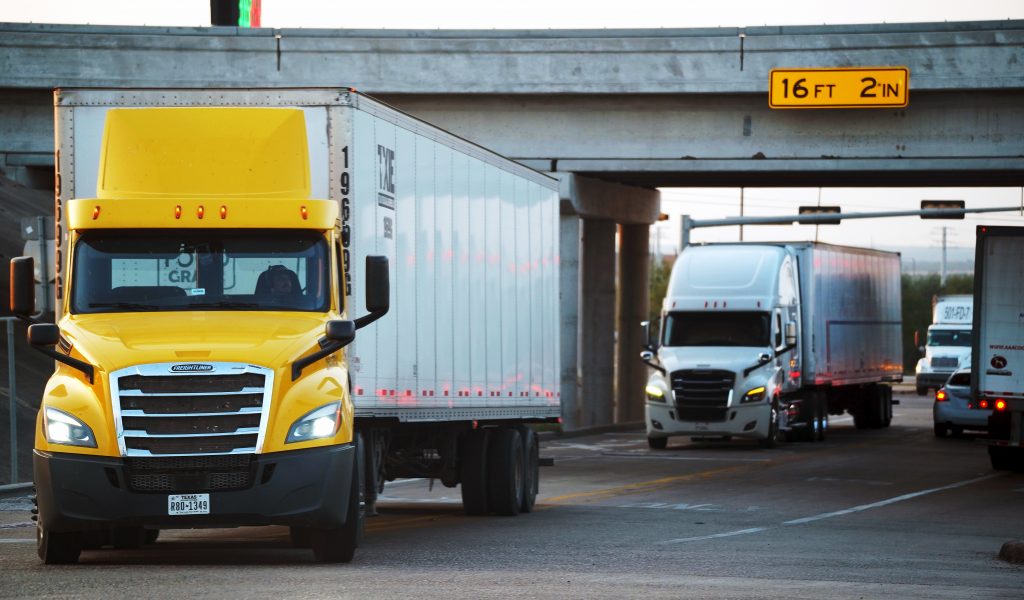CAMPUS: TAMIU study highlights hurdles for electric tractor-trailers at border
By Ivana Rodriguez
Bridge contributing writer
Published Tuesday, Nov. 25, 2025
The future of cross-border trade at the world’s busiest land port could depend on how quickly the transportation industry transitions to cleaner vehicles, but experts say significant obstacles stand in the way.
Texas A&M International University’s Texas Center for Border Economic and Enterprise Development Director Daniel Covarrubias said research on the transition to zero-emission transportation shows both opportunities and barriers.

Tractor-trailers drive by the Mile 13 marker on Interstate 35 in Laredo, Texas, on Nov. 18, 2025.
“Electric vehicles are zero emission, natural gas tractor-trailers are near zero and diesel engines are getting cleaner,” Covarrubias said. “But to get companies to replace a $180,000 diesel tractor-trailer with a $400,000 electric tractor-trailer, there’s just no incentive right now.”
Covarrubias and his team have focused their work on the unique dynamics of Laredo’s drayage system, where short-haul tractor-trailers transport goods back and forth across the border between Laredo, Texas, and Nuevo Laredo, Mexico. He said this type of operation is ideal for electrification because vehicles typically complete only about two and a half crossings per day.
“That, I think, would be perfect for electric tractor-trailers,” Covarrubias said. “You can charge them at night and have them do those crossings without issues.”
Still, major infrastructure gaps remain. Electric charging stations are rare along major freight routes like Interstate 35, and that lack of availability is one of the most significant barriers to widespread adoption.
“The infrastructure is not there yet,” Covarrubias said. “You’ll pass 10 gas stations on I-35 before you find one electric charging station for a tractor-trailer.”
The study also found that while zero-emission vehicles are ideal, diesel engines have become significantly cleaner in recent years.
“New diesel engines are very efficient,” Covarrubias said. “They’re not zero emission, but they’re right there. So that was a big thing that we discovered.”
Another key challenge is workforce readiness. The shift to electric vehicles will require new types of technicians trained in high-voltage systems, as well as data specialists capable of analyzing large amounts of information to plan efficient routes and manage charging schedules. Covarrubias emphasized that preparing the workforce for these changes is a major focus at TAMIU. Programs in transportation and management information systems now integrate courses on artificial intelligence, data analytics and digital transformation. Students are also encouraged to pursue micro-credentials and certifications to build specialized skills.
TAMIU senior transportation and international logistics major Sebastian Aguilar said sustainability and technology are becoming central topics in his field.
“In one of my classes, I learned that 28% of the carbon footprint in the world is transportation,” Aguilar said. “It’s an important matter to take a look at.”
Aguilar, who also serves as president of the Transportation and Logistics Network at TAMIU, said hands-on experience has been essential in understanding the industry’s shift. He recently visited a company that is incorporating artificial intelligence into its operations to improve efficiency.
“AI is going to help a lot with sustainability processes, not just in Laredo, but across the country,” Aguilar said.
He also believes students must go beyond classroom learning to succeed in the industry.
“It’s not the same, what you’re seeing in the book and actual hands-on experience,” Aguilar said. “That’s something I’m really considering as I’m about to graduate this December.”
For Aguilar, sustainability is not just about protecting the environment but also about improving efficiency.
“Lean manufacturing is something we’re seeing in different industries,” he said. “Let’s not use too much of a product because it’s going to cost more to the company and it’s less efficient.”
Despite the challenges, Covarrubias believes collaboration will be key to progress. He points to the concept of the “quadruple helix,” where the private sector, government, academia and the public work together to drive innovation.
“That’s when things work the best,” Covarrubias said. “You need trucking companies, incentives from the government, unbiased research from academia and public support.”
Pilot projects involving electric tractor-trailers are already underway in Laredo, but adoption remains limited. Only a handful of companies are testing small fleets, a tiny fraction of the more than 16,000 tractor-trailers that cross the border daily.
“Hopefully, in the next 10 years we’ll see the push,” Covarrubias said. “But without incentives, it’s not going to happen.”
For now, the conversation in Laredo highlights both the urgency of cleaner air and the economic realities of the freight industry. As Aguilar put it, students like him are eager to be part of the solution.
“I think, as students, we can make a difference not just here in Laredo, but across the country,” he said.
